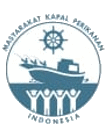LAJU KEMUNDURAN MUTU IKAN LELE (Clarias sp.) PADA PENYIMPANAN SUHU CHILLING
Abstract
Full Text:
PDFReferences
Apriyantono A, fardiaz D, Puspitasari NL, Sedarnawati Y, Budianto S. 1989. Petunjuk Laboratorium Analisi Pangan. Bogor: Pusat Antar Universitas Pangan dan Gizi. Institut Pertanian Bogor.
[BSN]Badan Standarisasi Nasional. 1992. Standar Nasional IndonesiaIkan SegarSNI01-2729-1992. Standar Nasional Indonesia. Jakarta.
[BSN] Badan Standarisasi Nasional. Standar nasional Indonesia 01-2345-2006. Uji Organoleptik Ikan Segar. Badan Standarisasi Indonesia. Jakarta.
Eskin NAM. 1990. Biochemistry of foods. Second edition. San Diego:Academic Press. Inc.
Erikson U, Misimi E. 2008. Atlantic salmon skin and fillet color changes effected by perimortem handling stress, rigor Mortis, and Ice Storage. Journal of Food Science 73 (2):50-59.
FAO. 1995. Quantity and Quality Changes in Fresh Fish, by Huss, ed. Rome: FisheriesTechnical Paper No.384. 95 pp.
[FAO] Food and Agriculture Organization. 1995. Quality and Quality Changes in Fresh Fish. Hus HH (ed). Rome: FAO Fisheries Technical Paper No. 331. 75 pp. 0-65.
Farber L. 1965. Freshness Test in Fish as Food. New York: Academic Press.
Fardiaz S. 1987. Penuntun Praktek Mikrobiologi Pangan. Institut Pertanian Bogor. Bogor.
Gelman A, Glatman L, Drabkin V, Harpaz S. 2001. Effect of storage temperature and preservative treatment on shelf life of the pond-raised freshwater fish, silver perch (Bidyanus bidyanus). Journal Food Protection 64:1584-1591.
Grigor JM, Theaker JB, Alasalvar C, O’hare WT, Ali Z. 2002. Analysis of Seafood Aroma/odour by Electronic Nose Technology and Direct Analysis. Dalam : Seafood-Quality,Technology and Nutraceutical Applications.Alasalvar C dan Taylor T (eds). NewYork: Springer.
Hadiwiyanto S. 1993. Teknologi Pengolahan Hasil Perikanan Jilid 1: Teknik Pendinginan Ikan.CV Paripurna. Jakarta
Ilyas S. 1983. TeknologiRefrigrasi Hasil PerikananJilid 1. Teknik PendinginanIkan. CV. Paripurna. Jakarta.
Irawan A. 1995. Pengawetan Ikan dan Hasil Perikanan. Cara Mengolah dan Mengawetkan secara Tradisional dan Modern. CV. Aneka. Solo.
Junianto. 2003. Teknik Pengawetan Ikan. Penebar Swadaya. Jakarta.
Karungi C, Byaruhanga YB, Moyunga JH. 2003. Effect of pre-icing duration on quality deterioration of iced perch (Lates niloticus). Journal Food Chemistry 85: 13-17.
Lan NT, Dallsgaard A, Cam PD, Mara D. 2007. Microbiological quality of fish grown in wastewater-fed and non wastewater-fed fishpond in Hanoi, Vietnam: influence of hygiene practices in local retail markets. Journal Water and Health 5: 209-218.
Leksono T, Amin W. 2001. Analisis pertumbuhan mikroba ikan jambal siam (pangasius sutchi) asap yang telah diawetkan secara ensiling. Jurnal Natur Indonesia 4 (1).
Nurjanah, Tati N, Fatmawati Z. 2007. Karakteristikmutu ikanbandeng (chanoschanos) di tambaksambirotokabupatenpatijawatengah. Jakarta:Seminar International Perikanan 2007.
Osibona AO. 2011. Comparative study of proximate composition, amino and fatty acids of some economically important fish species in Lagos, Nigeria. African Journal of Food Science 5(10): 581-588.
Ozogul Y, Ozyurt G, Ozogul F, Kuley E, Polat A. 2004. Freshness assessment of europeaneel (Anguilla anguilla) by sensory, chemical, and microbiological methods. JournalFood Chemistry92: 745-751.
Rehbein H. 1979. Development of an enzymatic method to differentiate freshand sea-frozen and thawed fish fillets. Z LebensmUnters Forsch169:263-265.
Sakaguchi M. 1990. Sensory and non-sensory methods for measuring freshness offish and fishery products. Didalam Science of Processing Marine FoodProduct.Motohiro T, Hashimoto K, Kayama M and Tokunaga T (Editor).Japan:International Agency.
Stein LH, Hirmas E, Mevik MB, Karlsen R, Nortved R, Bencze AM, SundeJ,Kiessling A. 2005. The effects of stress and storage temperature on thecolour and texture of pre-rigor filleted farmed cod (GadusmorhuaL.). Aquaculture Research 36:1197-1206.
Udo PJ. 2012. Investigation of the biochemical composition of heterobranchus longifilis, Clarias gariepinus and Chrysichthys nigrodigitatus of the Cross River, Nigeria. Pakistan Journal of Nutrition 11(10): 865-868.
Yunizal dan Wibowo. 1998. Penanganan Ikan Segar. Jakarta: Instalasi penelitian Perikanan Laut Slipi.
Zaitsev K, Kizeveter I, Lagunov L, Makarova T, Minder, Podsevalov V. 1969. Fish Curing and Processing. Moscow : Mir Publisher.
Zakaria, R. 2008. Kemunduran Mutu Ikan Gurami (Osphronemus gouramy) Pasca Panen pada Penyimpanan Suhu Chilling. [Skripsi] Teknologi Hasil Perikanan. IPB. Bogor. Bogor.
DOI: https://doi.org/10.35308/jpt.v5i2.1036
Refbacks
- There are currently no refbacks.
Copyright (c) 2019 JURNAL PERIKANAN TROPIS
Jurnal Perikanan Tropis (print ISSN 2355-5564 ;online ISSN 2355-5572), is published by the Faculty of Fisheries and Marine Science Universitas Teuku Umar, Indonesia .

This work is licensed under a Creative Commons Attribution-NonCommercial-ShareAlike 4.0 International License










